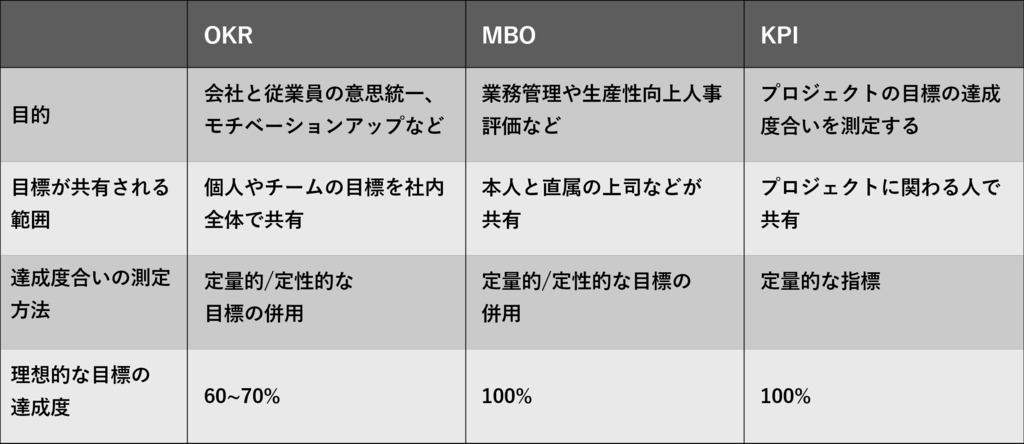Note: This website was automatically translated, so some terms or nuances may not be completely accurate.
How can OKR be linked to corporate growth? Consider the differences from KPI and MBO, and think about goal setting suited to your organization.
In this article, the Transformation SHOWCASE editorial team explains trending terms in the business and marketing world. This time, we focus on "OKR," a goal-setting methodology that has gained significant attention in recent years. A staff member from the Transformation SHOWCASE editorial team, who is a new manager leading various projects, shares insights from a frontline perspective.
OKR is a methodology adopted by many growing companies to achieve ambitious goals

As long as you belong to an organization, you cannot escape goal setting and evaluation. My team is currently in the midst of setting goals for our regular evaluations. Until a few years ago, I set my own goals and was evaluated by my supervisor. Now, in the position of evaluating subordinates, I increasingly feel the difficulty of aligning individual growth with the company's growth trajectory.
As a still-novice manager, I researched various goal-setting methodologies from perspectives like "What constitutes fair evaluation for individual staff?" and "What kind of evaluation fosters the growth the company seeks?" This led me to discover multiple evaluation approaches: "OKR, " "KPI," "MBO," and more.
To enhance my own personnel evaluation skills, I'd like to focus on "OKR" – which provided new insights during this exploration – and summarize its benefits and points to note.
What is OKR?
OKR stands for "Objectives and Key Results," a goal management technique used in business settings. True to its name, it involves setting "objectives" and "key results" at the company-wide, team, and individual levels. By clarifying the company's aspirations and translating them into team and individual goals, everyone works together toward the same direction, aiming to achieve ambitious targets.
OKR sets ambitious goals to drive growth
While the detailed setup and implementation of OKRs vary by company, they generally share the following characteristics:
- Set ambitious goals and aim for 60-70% achievement
- Set several key results for each objective
- Make the outcome metrics quantifiable and measurable
- OKRs are made public across the entire organization so anyone can review them
- Treat them strictly as a method for achieving goals; do not incorporate them into performance evaluations
In OKR, the first step is setting objectives. A key point is that these objectives should not be easily achievable; they should be set slightly higher for the individual. Aiming for 100% achievement tends to lead to passive goal setting, so achieving around 60-70% is the baseline. Next, set key performance indicators (KPIs) to achieve these objectives. Ideally, KPIs should be quantifiable and easily measurable.
While many companies link goal management to performance evaluations, the purpose of OKRs is to drive growth for individuals, teams, and the entire organization by pursuing ambitious goals. Using OKRs to evaluate employees—such as lowering performance ratings for unmet OKRs—makes it difficult to set challenging goals. Therefore, it is fundamental to keep OKRs separate from performance evaluations.
In fact, within my own organization, some staff prioritize human connections and personal growth through those relationships over monetary rewards. I felt OKR holds significant potential to unlock the potential of people who hold such values.
Next, to better understand the characteristics of OKRs, let's examine how they differ from other goal management methods. Common goal management and management metrics used in business include "MBO" and "KPI."
MBO is a metric directly linked to performance evaluations.
Similar to OKR is the management technique called "MBO (Management by Objectives)." This method, proposed by economist Peter Drucker, aims to improve the overall performance of the organization by having each employee set goals and achieve them.While it shares similarities with OKR in linking individual goals to company objectives, a major difference is that MBO often directly impacts personnel evaluations. It typically involves setting quotas, with achievement levels serving as a key factor in decisions like promotions and raises. Additionally, MBO differs from OKR in that individual goals are often not shared beyond the direct supervisor or management, and it fundamentally views 100% achievement as success.
KPIs are checkpoints for project success
Another concept often compared to OKRs is "KPI (Key Performance Indicator)." The purpose of KPIs is not individual or team growth, but to measure the degree of achievement of project goals. They serve as intermediate metrics, anticipating the necessary steps to achieve the ultimate goal (KGI) and checking whether those steps are being met.Therefore, KPIs must be "quantitative metrics" where achievement can be judged by clear numbers or other measurable data. In contrast, OKRs are set by combining "quantitative outcome metrics" with "qualitative goals" that cannot be measured numerically. Furthermore, like MBO, KPIs generally aim for 100% achievement.

Aligning the Direction of the Company and Individual Employees with OKRs

OKRs offer various benefits. Representative ones include the following:
- Sharing Clear Goals and Priorities
It clearly communicates the company's objectives to employees, fostering a sense of purpose. It also clarifies important challenges and the work that should be prioritized, making it easier to determine priorities and leading to increased productivity. - Enhanced Employee Motivation
Employees understand how their individual contributions connect to the company's overall goals, which is expected to boost motivation. - Enhanced internal communication
Since OKRs are shared company-wide, employees gain insight into each other's goals. This creates opportunities for exchanging ideas and seeking advice. Regular reviews also promote communication between employees and their managers. - Fostering an Organizational Culture That Embraces Ambitious Goals
Traditional methods often resulted in safe goals based on past performance or current circumstances. With OKRs, the fundamental approach is to set deliberately ambitious goals rather than aiming for 100% achievement, fostering a more challenging organizational culture.
Many Growing Companies Adopt OKR
OKR is said to have first been introduced at Intel in the United States. In the late 1970s, facing a management crisis, Intel adopted OKR as a method to turn things around and reform the company internally. Later, the early-stage Google also implemented OKR and experienced rapid growth. Silicon Valley IT companies and others began adopting OKR one after another.
In Japan, a flea market app operator adopted OKRs. As the business expanded and employee numbers grew, OKRs are said to have strengthened the bond between management and staff, fostered a challenging corporate culture, and contributed to the company's overall growth.
The key to OKR implementation is communication with employees
Finally, let's cover key considerations for maximizing the effectiveness of OKR implementation.
- Set clear deadlines
First, scheduling is crucial. Setting a cycle—such as quarterly or semi-annually—and clearly defining "by when to achieve" enables both individuals and teams to aim for steady growth. It's also important not to set an excessive number of goals, but rather to focus on a smaller number and concentrate efforts during that period. - Set goals at the appropriate level
Aim for goals that are challenging to achieve easily, yet never impossible. The essence of OKRs lies in setting innovative goals that go beyond maintaining the status quo, focusing instead on what the team and customers truly need. - Conduct Regular Reviews
Conduct regular meetings to review and check progress. Setting goals isn't the end; it's crucial to have frequent opportunities to reflect, confirm your intended direction, and identify what needs to be done now. Discussing goals and fostering active communication also contributes to enhancing employee engagement.
Furthermore, to effectively leverage these methods for personal and company growth, it is vital to thoroughly understand the organization you belong to.
It's also necessary to review how goals have been set internally in the past and what level of achievement has been attained. For example, in an organization where goals were previously set but rarely achieved, suddenly introducing OKRs might leave many staff unable to keep up with the ideal. First, it's essential to firmly establish within the company the mechanisms for goal management and the methods for creating concrete action plans to achieve them.
In other words, it's not about blindly implementing OKRs in any organization. What matters is that we, as managers, thoroughly understand the characteristics of the company, the team, and each individual, and earnestly consider what is the optimal evaluation method for this organization right now. Isn't it only through this process that we can approach the most appropriate goal-setting method for the organization?
OKR is gaining attention as a new goal management approach distinct from traditional MBO or KPI. By sharing goals between the company and employees, it can boost employee motivation and engagement. After carefully observing your company's situation, try adopting the goal management method most suitable for your organization and its staff.
The information published at this time is as follows.
Was this article helpful?